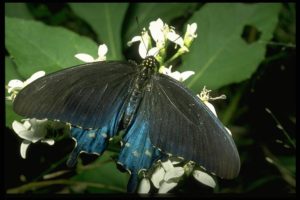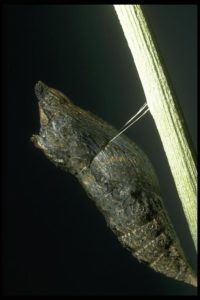
Black swallowtail, Papilio polyxenes asterius Stoll (Lepidoptera: Papilionidae), adult. Photo by Drees.
Common Name: Black swallowtail
Scientific Name: Papilio polyxenes asterius Stoll
Order: Lepidoptera
Description: The black swallowtail is a black butterfly with yellow markings near the margins of the forewings and hindwings and more limited blue and red markings on the hindwings. Its wing span can reach 4 ½ inches. Full grown parselyworms or caterpillars can reach 2 inches in length and are smooth and green, marked with black bands and yellow spots.
The black swallowtail mimics the bad tasting pipevine swallowtail, Battus philenor (Linnaeus), which is all metallic black-blue on the upper surface of the wings, lacking the yellow and blue markings. Caterpillars feed on pipevines, Dutchman’s-pipe and Virginia snakeroot.

Black swallowtail, Papilio polyxenes asterius Stoll (Lepidoptera: Papilionidae), caterpillar. Photo by Drees.
Life Cycle: Winter is spent in the chrysalis (pupa) stage. Adults emerge in the spring and seek host plants. Females lay round, yellow to cream colored eggs on the leaves. Caterpillars hatching from eggs are initially black with a white saddle. After molting several times, each larvae transforms into a pale green chrysalis that is suspended from a plant stem by a thread.
Habitat and Food Source(s): Caterpillars have chewing mouthparts. Adults have siphoning mouths. Host plants of the caterpillar include members of the parsley family (Umbelliferae) including carrot, parsley, dill, fennel and Queen Anne’s lace and some members of the Rutaceae (Ruta graveolens and Thamnosma texana). This caterpillar is bad tasting to birds and other predators because of toxins absorbed from the host plants. Like other larvae of swallowtail butterflies, parselyworms have a defensive structure, called an osmeterium, right behind the head. This structure is usually concealed. However, when disturbed this “Y” or “V” shaped organ is inverted. It emits a strong odor that is apparently distasteful to predators. This butterfly is easy to attract and raise by planting dill or fennel in your vegetable garden.
- Pipevine swallowtail, Battus philenor (Linnaeus) (Lepidoptera: Papilionidae). Photo by Drees.
- Black swallowtail, Papilio polyxenes asterius Stoll (Lepidoptera: Papilionidae), chrysalis. Photo by Drees.
Pest Status: Caterpillars feed on dill, fennel and some other plants; medically harmless.
For additional information, contact your local Texas A&M AgriLife Extension Service agent or search for other state Extension offices.
Literature: Howe 1975. Wright 1993.

